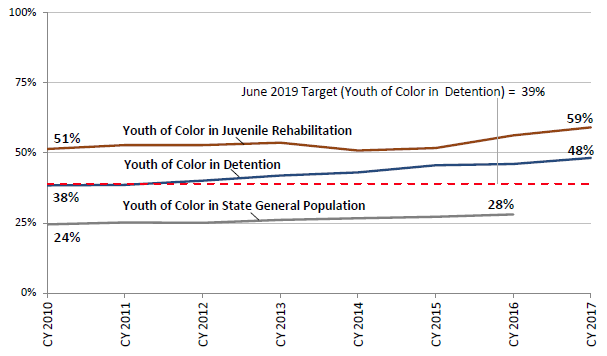Archived: Decrease percentage of African American, Hispanic and Native American youth in detention
Youth of color are over represented at every point in the juvenile justice system, including detention (county and state). These disparities often result in extreme negative consequences, which is the opposite of what we want for our youth, families, schools, businesses and citizenry.
The total number of youth in the juvenile justice system has declined over time; however the percentage of youth of color in detention is increasing. Nationwide Disproportionate Minority Contact (DMC) trends show over representation of minority youth increasing at each point along the juvenile justice continuum. In Washington State youth of color represent 36% of the general population between 10-17, 48% of youth in county detention, and 54% of the youth involved in Juvenile Rehabilitation. The greatest disparities exist for Black, Native American and Hispanic/Latino youth.
The Rehabilitation Administration (RA) will reach out to local jurisdictions and communities of color to encourage development of local initiatives, provide technical assistance, and encourage greater political and community involvement. This will increase community action andsupport change on a local level.
RA will convene experts and community members to develop recommendations for addressing school discipline and dropout prevention that disproportionately contributes to higher rates of juvenile justice involvement for youth of color.
RA is working with Counties/Juvenile courts to develop more precise plans to reduce Disproportionate Minority Contact (DMC). This will increase awareness and direct action at the county level regarding reducing disparities for youth of color who enter the county juvenile justice system.
Discuss these issues with your community leaders and develop solutions together:
Support Community Partners working with At-Risk Youth:
Become a Mentor
- JR Mentor Program
- Partnering for Youth Achievement – Kitsap County
Utilize the School-Justice Partnership National Resource Center for best practices in:
- School discipline (see other options here)
- Law enforcement
- School resource officers
- Mental and behavioral health providers,
- Engaging multiple stakeholders and partners for effective school-justice partnerships
Hire a youth working towards a more positive future
Learn more about DMC
Ask us for more information about responding to disproportionate minority contact
Washington State Partnership Council on Juvenile Justice DMC Information
